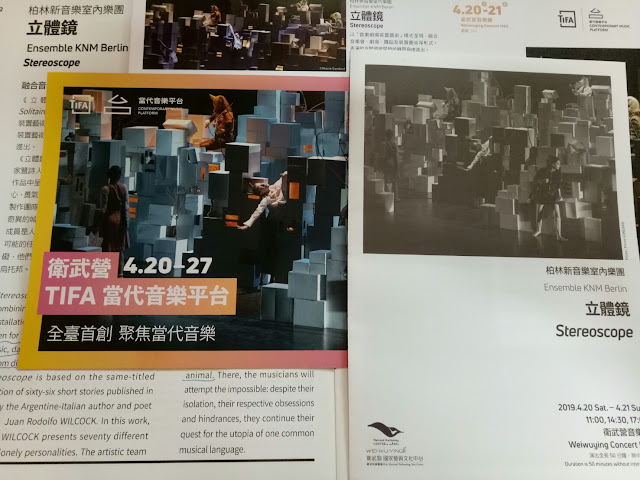Ensemble KNM Berlin's Stereoscope: Seeking the Unseeable in Loneliness
Inspired by the short stories published in 1972 by Argentine-Italian writer Juan Rodolfo Wilcock, Ensemble KNM Berlin's Stereoscope carves out solitary individuals in Wilcock's book. These individuals become ones playing musical instruments on their own, isolated but not always is the way it seems. While the individuals are mostly portrayed as lonely ones on the edge of the world, audiences are invited in the Stereoscope for seeking more unexpected dimensions on loneliness during the performance. An adventurous journey unfolds as it allures audiences into the stage. Positively the loneliness can be abundant through interaction during the performance. Through walking around the stage, audiences set out seeking loneliness in quirky ways.
Stereoscope came to the question emerged between seeing and listening during the performance. As audiences did not always see the musicians playing their instruments, they instead paid much attention to the sound-making. Various sounds emerged as if they were coming in simultaneous moments. It became interesting for me to find where the sound came from. As an audience, if I took the seat in the auditorium, I immediately discovered what kind of musical instruments the musicians were playing. But if I stepped in and wandered around the stage, searching for the sounds naturally caused primary concern. Most of the times I hardly observed the musicians. Such the intriguing experience excited audiences, for it challenged the parallel between the image of sound and of seeing. By seeking the origin of the sounds, the sounds to which we were listening did not always equate with the musical instruments played by the musicians hidden in the white boxes. Seeking the origin of the sounds, the musical instruments such as violin, cello and trumpet were found to make them. Most of the time I felt squeamish as the sounds kept going on and meanwhile was amazed by the finding of where the sound-making came from.
The audiences who stood on stage found something wrong by listening to the sounds-making, which caused a sense of curiosity between the audiences and the performers. An unfamiliar sense caused as one tended to match the sounds by musical instruments. These sounds somewhat mark the traces of how loneliness were unfolded. Although sounds like noise, or any other voices that were quite barely recognized as what they were, people on stage were easily attracted by these sounds during the performance. Entering the city piled up by the white boxes, audiences were like aliens who intruded the city. One of the audiences heard the sound and followed it from one of the musicians. By lifting his head, he desired to see something hidden behind the white boxes and tried further to see where the sound was coming from. The musician meanwhile noticed this audience and was frightened by the shadow of this man. An encounter with both was created as if the man accidentally found this musician performing music on his own. Both of them might be scared at each other, but the interesting part was that they sense their loneliness until they encounter with each other. There might be a process of encounter that appears, unmasking a sense of scary, of unknown feeling and of happiness between them.
The audiences keep tracing the origin of the sound-making, and the objects used for arts installation unveiled the sides that we seldom saw. The objects mainly came from local stuffs in Kaohsiung, Taiwan and were mostly recycled as disposed; however, the artists took good use of them to create artistic works in the performance. Stuffs like donuts-like toys, as I firstly took my step on the performance stage, pushed me to think of the modern time in living. Such the simple trinket might implied the foreign intrusion resulted from the booming global impacts on local culture and a strong sense of inevitable forces from the foreign culture under this current era, but it somehow showed a sense seldom perceived while mostly valued for the plaything as mass production in usage, not for the basis of emotional bonding between object and human. Although the toy brought a sense of delight for most people in their life, it exposed the side of capitalism as labours worked in the factory mainly for plastic toys manufacture.
The sense of loneliness hardly seen in the public could be observed by its installation, which challenged the audiences' eyes by paying much attention to the objects displayed in the white boxes. Others in this installation also play different roles in their functions barely seen. Walking in the back of the stage, a small table lamp caught my eyes. Closely looking at the lamp, I found that its upper part was the cup upside down used for worshiping Chinese gods or ancestors. Its lamp post was a chopstick that held this art work. There were also many screws on some of the art works as they constructed various models though I barely recognized what they really were. What amazed me were the capsules, usually regarded as the medicine. The capsules in the installation set as stones strongly held the other objects within. A glass bottle marked Taiwanese brand gave me a close connection to the art work due to my hometown. These objects mentioned above were familiar in our daily life for we took them by knowing how to used them based on the objects' functions; nonetheless, they were displayed by artists' delicate rearrangement. This caused the audiences' seeing as to how they saw the familiar objects that could generate those unfamiliar parts along with their ways of seeing.
The way that the audiences joined in the performance did not simply see those lonely sides as the solitary individuals in Wilcock's book. The audiences invited to walk around the stage and find things becomes the ways of seeking how loneliness unfolds. This finding process opened up the boundary of one's normal experiences on loneliness. As I was walking around the stage, the dancers, who led the audiences to the performance, were performing with the sound of music. One of the dancers was twitching with his body when the tune changed suddenly. With their quick and slow movements, their dancing characterized a sense of pain, of desolation and even of depression in an unstable atmosphere on the stage. Most of the audiences on stage were quite easy to go with them. One could sense how the loneliness became mad, and sometimes ones who were on stage might feel dangerous when walking around. In exploring the journey of Stereoscope, the audiences would go through the performance that helped them see/seek what was concealed in the performance.
Reference: https://www.npac-weiwuying.org/programs/5c135914924fb30006bd6f3d?lang=en



Comments
Post a Comment